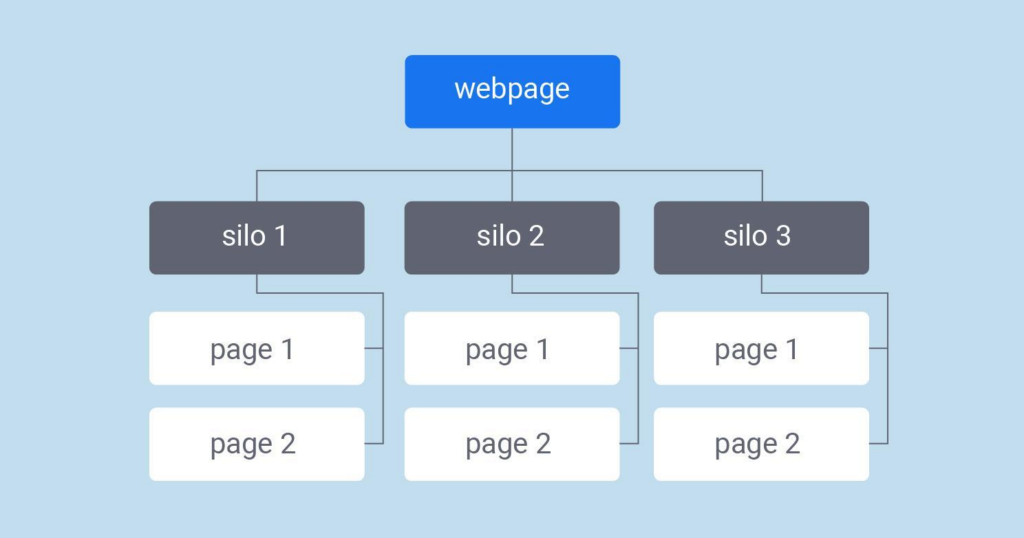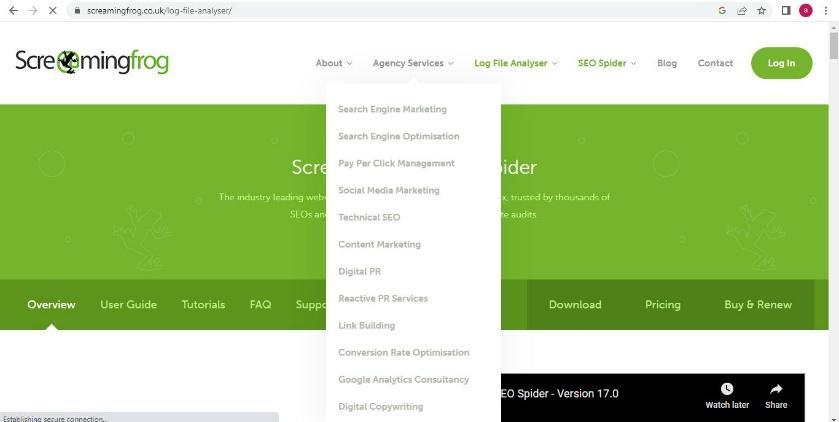When it comes to improving your website’s search engine rankings, implementing an SEO silo structure can be a game-changer. By using an SEO silo structure, you can create a well-structured and easily navigable website architecture that boosts user experience and facilitates search engines to index your content more effectively.
This comprehensive guide will delve deep into SEO silo structures, exploring their benefits and comparing them with flat structures. You’ll learn about different types of silos, such as top-down recycle, reverse, serial, YOLO, and priority silos, through practical examples.
We’ll also discuss various methods for creating virtual and physical silos within your website’s URL and link structure. Additionally, we will introduce some useful auditing tools that can help you optimize your site’s hierarchy for maximum impact on search engine results.
In conclusion, we’ll evaluate the pros and cons of utilizing an SEO silo structure so that you can make a well-informed decision regarding its appropriateness for your particular requirements.
What is a Silo Structure?

A silo structure is an organizational method used in digital marketing to categorize and arrange content into related topics. By categorizing and connecting related topics, silo structures aid search engines in understanding the relationship between different pieces of content on a website.
Implementing a silo structure can improve your site’s on-page SEO, making it easier for search engines to crawl and index your pages, ultimately leading to better rankings and increased organic traffic.

Source: cmlabs
The Importance of Content Organization
Organizing your website’s content is crucial in helping users and search engines navigate through the information you provide. A well-structured site lets visitors find what they’re looking for quickly while allowing search engine bots to crawl efficiently, index, and rank your pages based on their relevance.
Why Use a Silo Structure?
Silo Structure Components
There are several key components to consider when implementing a silo structure on your website:
Incorporating proper linking, anchor text, and organization into your website can improve user and search engine navigation, potentially boosting SEO performance.
Flat Structure vs. Silo Structure
Organizing your website’s content in digital marketing plays a crucial role in improving its SEO performance. There are two primary ways to structure your content: flat and silo structures. Comprehending the distinctions between these two approaches can aid in deciding which is most appropriate for your objectives.
Flat Structures
A flat structure refers to a single-layer organization where all pages on a website are accessible from the homepage or main navigation menu without any hierarchy or categorization. A flat structure can benefit smaller sites with limited content, allowing users and search engines to access all available information easily.
However, suppose the website expands in size and complexity. In that case, this approach may become ineffective due to difficulty comprehending connections between various pieces of content, which could result in reduced SERP rankings and organic traffic.
However, as your website grows in size and complexity, using a flat structure may become less efficient due to difficulties understanding relationships between different pieces of content. Consequently, this could decrease rankings on search engine results pages (SERPs) and reduce organic traffic.
Silo Structures
In contrast, a silo structure organizes webpages into related topics and subtopics based on their relevance within specific categories or themes. By doing so, it provides clear connections between various pieces of content, which not only improve user experience but also help search engines comprehend the relationships among them more accurately.
Moz explains that implementing an SEO-friendly silo structure can improve rankings by allowing search engines like Google to recognize topical authority within niche subjects better.
Silo structures enable you to create targeted content that appeals specifically to certain audiences or interests – ultimately increasing engagement rates among visitors who find value in your offer.
Choosing the Right Structure for Your Website
To determine which structure is best suited for your website, consider factors such as:
SEO Benefits Of A Silo Structure
Implementing a silo structure on your website can significantly improve its SEO performance. This section will discuss some key benefits of using a silo structure for SEO.
Better Indexation by Search Engines
A well-organized silo structure makes it easier for search engines like Google and Bing to crawl and index your website’s content. This is because related content is grouped within categories or subcategories, allowing crawlers to navigate your site’s hierarchy easily. As a result, your web pages are more likely to be indexed accurately in SERPs.
Increase in Topical Authority
Silo structures help establish topical authority by grouping similar content under one umbrella topic. This allows you to create comprehensive resources around specific subjects demonstrating expertise in your niche.
When search engines recognize this level of organization and depth of knowledge on particular topics, they may reward you with higher rankings for relevant keywords.
Tips for Building Topical Authority
Improved User Experience
A well-organized silo structure benefits search engines and enhances the user experience on your website. Organizing related content in the same area makes it simpler for people to locate what they need and easily move around your site.
A well-structured silo can improve user engagement and SEO performance, such as longer visits, lower bounce rates, and greater involvement.
Tips for Improving User Experience
SEO Silo Structure Example (Top-Down Recycle, Reverse, Serial, YOLO, Priority Silo)
By understanding the different silo structures available, you can determine the most beneficial for your website’s content marketing objectives. Each type has its advantages and disadvantages depending on your website’s needs.
Understanding these silo structures will help you determine which is best suited for your content marketing strategy.
The top-down recycle silo structure involves organizing content from broad to specific topics within a single category or theme. This allows users to easily navigate through related content while helping search engines understand the information hierarchy on your site.
An example of a TDR silo would be having a main category page about “Digital Marketing” with subpages covering more specific topics like “Content Marketing,” “Social Media Marketing,” and “Email Marketing.”
A reverse silo structure focuses on creating clusters of related pages around a central hub page instead of organizing them hierarchically, as in TDRs. The hub page serves as an overview or summary for all connected pages. It helps improve internal linking between those pages by providing relevant anchor text links within the body copy.
This approach can make it easier for search engines to crawl and multiple index pieces of closely-related content.
In serial silos, each piece of content acts as both parent and child within the overall structures, meaning every article connects directly with another in sequence without any overarching categories or themes connecting them at higher levels than their individual relationships allow.
This type offers flexibility when adding new content but may require more maintenance over time to ensure proper organization.
The YOLO silo structure is an acronym for “You Only Link Once.” In this approach, each page within a silo links only once to another related page, creating a linear path through the content. This can help maximize link equity between pages and improve overall SEO performance; however, it may need to be more user-friendly and easier to navigate than other structures.
A priority silo organizes content based on relevance to your website’s goals and objectives. High-priority pages are placed at the top of the hierarchy, while lower-priority ones fall further down.
This structure helps search engines understand which pieces of content should receive more attention when ranking results, potentially leading to higher organic traffic from SERPs due to the targeted nature of creation involved with PSs.
How to Silo a Website (Virtual, Physical, URL, Link)?
Siloing a website involves creating virtual or physical structures within your website that link related pieces of content together. This can be done through URLs or links that point from one page to another or by creating categories and tags that similarly group pieces of content.
This section will discuss various methods for effectively siloing your website.
Virtual Silos
A virtual silo is created using internal linking strategies to connect related pages on your site. Links between pages can be formed to make it easier for search engines to comprehend the connections among varied subjects and help users explore your website more quickly.
To create a virtual silo:
Physical Silos
In contrast to virtual silos, physical silos involve organizing webpages into folders based on their topic or theme. This method creates clear hierarchies in the site structure, which makes it easy for search engines to crawl and index pages accurately.
Here’s how you can implement physical silos:
How To Silo Your Website Efficiently?
Here are some of the best practices for successfully siloing your website.
Website Silo Structure Auditing Tools
A well-organized silo structure is essential for improving your website’s SEO performance. Various auditing tools can be utilized to identify areas where improvements could be made to guarantee that your website has an effective silo structure.
This section will discuss some of the most popular and useful website silo structure auditing tools available.
Screaming Frog SEO Spider Tool

Screaming Frog SEO Spider Tool is a powerful tool that crawls your website and provides valuable insights into its overall architecture, including its silo structure. With this tool, you can quickly identify broken links, duplicate content issues, missing meta tags, and other potential problems related to your site’s organization.
The tool also permits you to observe the hierarchy of pages on your site, helping you recognize any discrepancies in how content is structured.
DeepCrawl Web Crawler Tool
DeepCrawl Web Crawler Tool comprehensively analyzes websites’ structures by crawling all their pages and identifying technical issues affecting their performance in search engines. It helps detect orphaned pages (unlinked from anywhere), improper redirects, or URL structures and analyzes internal linking patterns within different site sections.

This information enables users to make informed decisions about optimizing their sites for improved visibility online.
Moz Pro Site Crawl Tool

The Moz Pro Site Crawl Tool, part of Moz’s suite of professional SEO tools, is another excellent option for auditing your website’s silo structure. This tool crawls your site and provides detailed reports on various aspects of its organization, including internal linking patterns, duplicate content issues, and broken links.
With the insights Moz Pro Site Crawl Tool provided, you can easily identify areas where improvements to your site’s silo structure are needed.
Other Tools Worth Considering
Sitebulb: A comprehensive website auditor that analyzes websites’ structures in-depth and identifies potential SEO problems.
Botify: An enterprise-level platform designed to help large-scale websites optimize their architecture for better search engine performance.
ContentKing: A real-time SEO auditing tool that continuously monitors website structure changes and alerts users about any potential issues affecting their online visibility.
By using these tools to audit your website’s silo structure regularly, you can ensure that it remains well-organized and optimized for maximum search engine visibility. Remember that an effective silo structure helps improve rankings and enhances user experience by making it easier for visitors to find relevant information on your site quickly.
Disadvantages Of Using A Silo Structure For SEO
Using a silo structure for SEO has advantages and disadvantages depending on your website’s needs. Deciding whether or not to use a silo structure requires careful consideration of the pros and cons.
Frequently Asked Questions About SEO Silo Structure
Conclusion
In conclusion, SEO Silo Structure is an effective way to structure your website and content to improve organic search engine rankings. Creating a logical hierarchy of topics on your website that allows users and search engines to navigate the pages easily is essential for successful SEO Silo Structure implementation.
While some disadvantages are associated with using this type of structure, it can be incredibly beneficial for increasing visibility in SERPs when done correctly. Make sure you audit regularly and use siloing tools such as Screaming Frog or Sitebulb to avoid any potential issues related to SEO Silo Structures.
Increase your online presence and build a following around your brand or niche with our comprehensive SEO Silo Structure solutions. Leverage the power of content marketing to reach more customers, engage them better, and drive higher conversions.